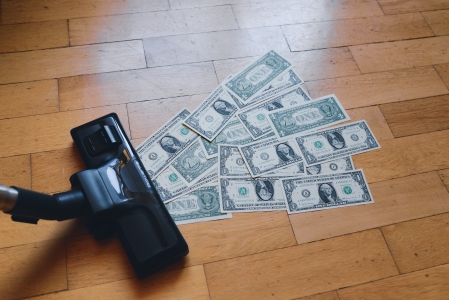What Is Fractional Investing & Fractional Shares?
Fractional shares are a relatively new phenomenon that has solidified a key role in the democratization of investing in previously prohibitive asset classes. Established by financial companies to allow more of the general public to trade the market’s hottest stocks, fractional sharing makes investing accessible to millions of individuals who wouldn't have been able to afford it.
Below, Vint breaks down fractional investing and fractional shares so that you can determine if it’s the right strategy for your investing goals.
What Is Fractional Investing?
There are two types of fractional investing. The first is purchasing portions or partial shares of a single share of a company, thus owning a fraction of the single share. With this first type of fractional investing, investors can purchase a partial share at one time. If the share prices are too high for the investor to afford, the investor can still buy stock.
The second type of fractional investing is when investors purchase shares of ownership of a single and group of physical items, ex. art, wine, baseball cards. Fractional investing is becoming more and more popular, and some of the world’s largest companies are offering it to investors.
With traditional investing, an investor buys shares in a company by purchasing whole shares. For instance, if you are interested in investing in a business with a stock price of $75, you must buy entire shares in $75 increments. And since some companies come with extremely high share prices, many investors do not have the option of buying in.
Or if you are investing in art, watches, or another collectible, traditionally you would have had to acquire and pay for the entire item by yourself. This high barrier to entry, excluded many individuals from participating in certain asset classes.
Many fractional investors who invest in shares of companies buy half a share or even a fifth of a share. This would mean that you own .5/100 or .2/100 of the outstanding shares of a given company. People use dollar-based investing to buy fractional shares, meaning you declare the amount you wish to invest in a specific company, and you purchase however many shares it takes to get to your amount.
If you have to pay a commission for partial shares, it probably isn’t worth it. Fortunately, however, most brokerages provide commission-free trading for fractional investing.
What Are Fractional Shares?
If you buy company shares that are less than the cost of full shares, you buy a portion of a share (a fractional share). If there is a company you want to invest in, and they offer fractional investing, then you will simply specify your spending power. The other type of fractional shares are full shares, that are backed by a physical or digital item.
What is an Example of a Fractional Share?
Let’s say, for instance, a company has a share price of $100. If you have $20 available to invest, you can buy a fifth of a share. If you have $120 to invest, you can purchase a share and a fifth. Note that these examples do not account for commissions and other fees.
The secondary type of fractional investing is purchasing a piece of a 2 million dollar artwork for $20,000 or investing in a collection of the Domaine de la Romanée-Conti, arguably the world's most collectible wine, for $25.
What Are Types of Fractional Shares?
Many people are factional investing through dividend reinvestment plans (DRIPs). With this type of plan, you can use your dividends to accumulate additional shares in the business paying the dividend. The more shares you buy, the more significant your dividend payment may be.
Though increasing in popularity, only specific brokerages offer fractional investing. If you are working with a broker that does not provide fractional shares as an option, then you must purchase whole shares. This means that you cannot buy shares in the example above if you only had $20, and if you had $120, you would be limited to one share.
Moreover, all brokers have their way of dealing with fractional shares. Some only allow it for S&P 500 businesses. Some do not allow investors to transfer fractional shares out of their accounts.
Some will group your fractional share orders with other orders or restrict trading times, potentially impacting the shares’ liquidity.
The secondary type of fractional shares are the kind you can purchase through a Regulation A+ certified company who creates SEC-qualified shares backed by physical and digital goods.
Why Would I Purchase Fractional Shares?
Let’s take a quick look at some of the primary benefits of buying fractional shares:
- You’ll have more portfolio diversity
- They lower the cost of diversification
- They work like full shares
- There’s more precision in your investment amount
Fractional Shares Offer More Portfolio Diversity
Before fractional investing came along, penny stocks were the only option for people with limited spending power. Penny stocks are from high-risk companies and rarely make for good investments.
With fractional shares, however, you can buy into a piece of any business that is publicly traded, and many of the largest corporations that trade for thousands of dollars per share are open to public trading.
The same goes for the most expensive collectibles in the world. Once available only to a select few to invest in, now top end collectibles are open and accessible to anyone.
In other words, no business or collectible is out of the question for fractional investing. This means that you can choose companies you think will bring you the highest return in the long run instead of basing your investment decisions on how much cash you have.
Fractional Shares Lower the Cost of Diversification
Like investing in fine wine or art directly, purchasing fractional shares is an excellent way to diversify your portfolio. By investing in many different companies, industries, or asset classes, your money is less tied up in a single class of assets, reducing your investing risks.
Because you are not required to spend as much money on fractional shares of stocks, you can diversify your portfolio less expensively than going the traditional route. You can take $200 and invest $50 in partial shares of companies in four different industries.
It’s important to note that fractional shares do come with risks. Some investors may not research appropriately when an investment comes with a low cost of entry. Moreover, purchasing fractional shares of stock in several companies comes with more risks than buying an index or mutual fund. But it also presents an opportunity to stay ahead of the market.
On the flip side, investing in shares of physical collectibles that have long track records of performance may help mitigate risk.
The key is to take time to research each investment. By using an intelligent strategy and putting the time and energy into diversifying your portfolio wisely, purchasing fractional shares allows you to choose investment opportunities that outperform the market (more so than if you were able to buy full shares). You don’t have to consider per-share price, which frees you to spend your money on businesses you predict will perform the best long-term.
Furthermore, if a specific company has a high stock price, you don’t have to wait until you have saved enough money for a full share. You simply invest a smaller amount to get started.
Fractional Shares Work Like Full Shares or Can Be Full Shares
If you choose to get into fractional investing, brokers will treat you as they would someone who is purchasing a whole share. You will get similar benefits from owning the stock and yield the same percentage gains. Of course, you also assume the same risks.
If your stock pays dividends, your payments will depend on how many fractional shares you own, just like other investors. For instance, if the stock’s shareholders get a $0.50 dividend for each share, you would receive $0.25 if you own a half share.
Another way fractional shares work like whole shares is that you can sell them like any other shares you own. For example, if you own a fifth share and decide to sell your stake, you can submit a sale order with your broker and cash out. This makes for a quick learning curve and an overall straightforward experience.
The case in which fractional shares are full shares are when you are purchasing your fully allocated share of a physical or digital good.
Fractional Shares Offer More Precision in Your Investment Amount & Asset Class
Before fractional investing, you were required to strategize your investments around the number of shares you could purchase. If you were after 100 shares of a stock with a $50/share trade price, you would need $5000 upfront. Or, if you had $100 to spend, you could buy two shares. Investing in fractional shares allows you to bypass individual share prices and zero in on the available amount of money. If you have $500, you can invest; you can simply purchase $500 of stock, requiring less time.
Additionally, before fractional shares of collectible assets, you were relegated to only investing in shares via the traditional market. New platforms like Vint and Masterworks allow offer platforms to invest in your passions such as wine and art.
Easy Automatic Investing
Previously, automatic investing was not available for individual stocks. The only option was to invest in mutual funds that offered partial shares. These days, many brokerages allow auto investing in stocks, meaning you establish a monthly dollar amount and allow the money to work for you.
Automatic investment plans in the past frequently left investors with extra money sitting until there was enough to purchase another share of stock.
What Are the Drawbacks to Fractional Investing?
There’s no getting around that fractional investing is a phenomenon that can benefit the general public, but there are some drawbacks to consider. First, you may need to pay various fees for purchasing certain stocks, so you must ensure each investment is worth it before committing.
Also, trading fractional shares can leave you with multiple tax lots, which can mean more work when filing tax returns. And if you receive dividends from the stock that you then reinvest, it adds even more work to your plate.
Another thing to consider is that many brokers have not caught up to the fractional investing phenomenon or simply have no plans to offer it. More and more brokers are adding it to their services, so chances are you can find one that will work with you. If you want to invest in individual stocks, confirm fractional investing is an option before opening an account.
Finally, the primary draw back with investing in collectible shares is that, historically, these investments take time to mature. This means that your money may be tied up longer than if you were investing via traditional investment channels.
“Wining Down”
There are many advantages to purchasing fractional shares, and to many the benefits will outweigh the drawbacks. As long as you work with a brokerage that doesn’t take out commissions or additional fees specific to fractional investing or work with a platform like Vint with zero on-goin management fees, you have more freedom to support a precise amount of money instead of basing your investment strategy around full share increments.
If you want to invest in companies you believe in without having your decisions determined by share prices; fractional investing could be an ideal option for diversifying your portfolio. Don’t forget that investing in wine through Vint is also the perfect path for building a diverse and fun portfolio.
Sources: Thanks to Fractional Shares, Trading Is Accessible to Everyone | Entrepreneur Best Brokers For Fractional Share Investing In March 2022 | Bankrate What Is an Automatic Investment Plan? | The Balance


